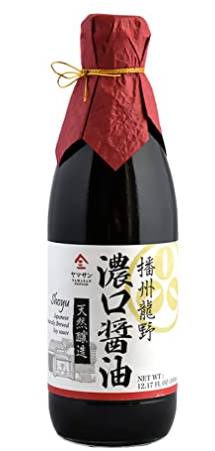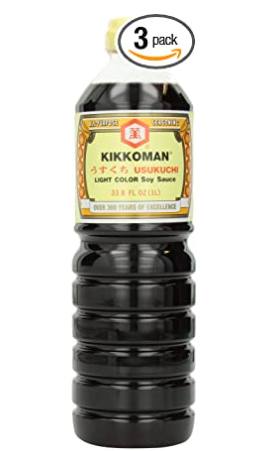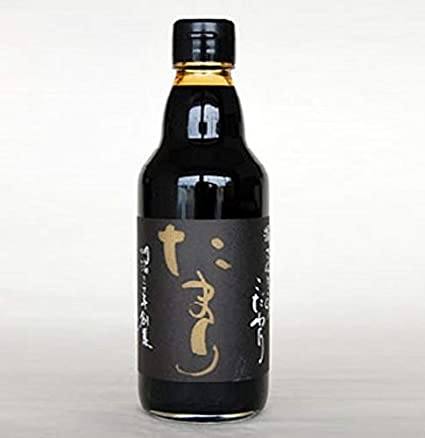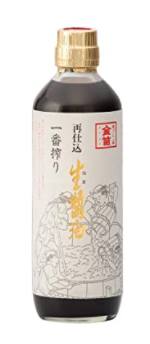Here are the best Japanese soy sauces for you to buy if you want to make an authentic Japanese dish or just use it as a delicious dip!
Experience the rich umami flavor of Japan with our guide to the best Japanese soy sauce. Dive into the world of traditional craftsmanship and discover soy sauces renowned for their depth of flavor and versatility.
Elevate your culinary creations with these top-rated soy sauces that embody the essence of authentic Japanese cuisine.
Which is the best Japanese soy sauce?
Yamaroku Shoyu is the best Japanese soy sauce. This soy sauce is traditionally barrel-aged, resulting in a complex umami flavor with a balanced sweetness and saltiness. It enhances dishes without overpowering them, making it a versatile choice for dipping, marinades, and cooking.
Best Japanese Soy Sauce -- Quick Summary
| Best Japanese Soy Sauce | Key Feature | Why Should You Get It? |
| Koikuchi Shoyu | Rich umami flavor | High antioxidant potency |
| Usukuchi Shoyu | Salty with a hint of sweet flavor | Light textured sauce as compared to others |
| Tamari Shoyu | Rich taste of soybeans without wheat | A great alternative for people allergic to wheat |
| Saishikomi Shoyu | Less salt content | Uses ingredients that are free of toxins |
| Shiro Shoyu | Brewed for one year to bring out the rich umami flavor | Great for cooking as well as dipping |
Top Japanese Soy Sauce
Koikuchi Shoyu
Best Japanese soy sauce for ramen
In the world of soy sauce, Yamasan soy sauce is one of the top known traditional soy sauces from Hyogo Prefecture. They provide products handled with precise methods and care while following authentic brewing methods and recipes.
This soy sauce has been brewed for more than a year to bring out its rich flavor. This one is just a three-ingredient sauce: wheat, soy, and water, which is absolutely delicious and natural in taste as no chemicals or preservatives have been used during the production.
In Japanese food culture, soy sauce plays an essential role and that being said, it becomes very important to choose the right one to make the dishes tastier. There is a subtle umami flavor in this sauce that you will definitely enjoy.

I prefer using it with grilled and boiled food and also for seasoning. This sauce has been made in a perfect environment of the Seto Inland sea where the mild climate and the waters of the Ibo River mingle up to provide the best of all tastes. Regarding its aroma, it is enthralling as the steamed soybeans and roasted wheat cannot be ignored.
Pros:
- Naturally produced sauce
- contains good health benefits
- High antioxidant potency
Usukuchi Shoyu
Kikkoman is one of the most famous brands of soy sauce. Usukuchi sauce is not an ordinary sauce but a completely different concept that is very versatile in nature. Other than just seasoning Asian cuisines, this soy sauce is also used for Western dishes and that is the reason, it is always in demand.
In terms of the texture, it is thinner, lighter in color, and has less darkness to the flavor, with more salt content and a hint of sweetness because of the rice wine. I have tried different sauces and this one is my all-time favorite as it can be used for all-purpose seasoning.

I like to use this soy sauce with marinades and vegetables as it doesn't stain the food deeply and you actually can taste its light flavor without overpowering the food. Alcohol has been used to preserve its freshness so you don't have to worry about finishing it faster.
Also, other than using this while cooking, you can also use it as a dip for your snacks. I have tried this as a dipping sauce for my stir-fries and trust me, it tastes amazing.
Pros:
- Light textured sauce as compared to others
- naturally brewed soy sauce
- More salt content with a hint of sweetness
- Works well as a marinade
Tamari Shoyu
Tamari is a well-known brand that specializes in traditional soy sauce which is prepared with good quality soya beans and with hardly any wheat. Earlier, Tamari products were devoid of wheat and hence, the taste was more about the soya beans rather than wheat. In the market, you can still find soy sauces made without wheat and this is one of them.

Talking about the flavor, it is strong and helps in making the dish taste perfect. There is a mild sweetness when you taste it and it just feels amazing. For better experiences, try this sauce with simmered dishes or simply as a dip for fried food to get that raw flavor.
If you are looking for an original soy sauce then you must go for this alternative option as there is less wheat content.
Pros:
- A great alternative for people allergic to wheat
- Rich flavor
Saishikomi Shoyu
Best traditional Japanese soy sauce
Made with traditional brewing methods while also focusing on the quality of ingredients, this Saishikomi Shoyu soy sauce is one of the best options to have in your kitchen. The taste is absolutely delicious and complex because it goes through double brewing which helps in keeping the actual flavor of soybeans intact.
Instead of using water and salt, this soy sauce is made with regular koikochi sauce and is kept for two summers to let the process work. During this procedure, the saltiness of this sauce gets removed which brings out the real taste of soy sauce.

I highly recommend this sauce for cooking meals and for pouring it on rice and meats. Since there is no salty flavor in it, I don't use it for dipping. I have also tried this with mirin for marinated ramen eggs and I am quite impressed with how it turned out without overpowering the dish.
Other than its flavor, this soy sauce is also known for its pure and toxin-free ingredients. Also, no preservatives or artificial flavors have been used in the preparation of this sauce. When compared to other soy sauces, this one is a far better choice to make as it will let you enjoy each and every flavor without pilling its own taste.
Pros:
- Less salt content helps in reducing blood pressure
- Does not overpower the dish
- Uses ingredients that are free of toxins
Kishibori Shoyu
Best Japanese soy sauce for sushi
Get this Kishibori Shoyo to enjoy the heavenly and delicious taste of soy sauce famous in Japan. It is a type of soy sauce that is made with high quality and toxin-free ingredients like soybeans, salt, water, and wheat.
The mixture of all these is brewed for a period of 1 year in a traditional 100-year-old cider barrel. The process is slow which results in the production of extremely smooth and flavorful soy sauce.
It tastes like umami, which is the delicacy of Japan as it is a blend of salty, sweet, sour, and bitterness that adds an amazing taste to the dishes.

Adding it to your gravy is another best option as it will change the taste instantly. In this soy sauce, no alcohol additives, artificial flavors or preservatives have been used and so you can actually taste the original flavor.
A soy sauce with less saltiness to it is what I have always wanted and trust me this one satisfied my palette. You must invest in this soy sauce to enjoy the beautiful flavor.
Pros:
- Brings out a rich umami flavor
- Smooth and flavorful
- Great for cooking as well as dipping
- No additives or preservatives
- Less saltiness
Kikkoman Halal and Gluten-Free Japanese Soy Sauce
Kikkoman Halal and Gluten-Free Japanese Soy Sauce is a great option for people who are looking for a soy sauce that is both gluten-free and halal. It has a rich, umami flavor that makes it perfect for a variety of dishes, including sushi, sashimi, stir-fries, and marinades.
The soy sauce is also made with traditional Japanese brewing methods, which gives it a deeper flavor than some other soy sauces.
One downside of Kikkoman Halal and Gluten-Free Japanese Soy Sauce is that it can be a bit salty. However, this can be easily adjusted by using less soy sauce in your dishes. Another downside is that the soy sauce is more expensive than some other soy sauces.
However, if you are looking for a high-quality, gluten-free, and halal soy sauce, then Kikkoman is a great option.
I would definitely recommend Kikkoman Halal and Gluten-Free Japanese Soy Sauce to anyone who is looking for a delicious, gluten-free, and halal soy sauce. It is a great addition to any kitchen and can be used in a variety of dishes.
Pros:
- Gluten-free and halal
- Made with traditional Japanese brewing methods
- Rich, umami flavor
- Can be used in a variety of dishes
- Long shelf life
Cons:
- Can be a bit salty
- More expensive than some other soy sauces
How to choose the best Japanese soy sauce?
Choosing the best Japanese soy sauce depends on your personal taste preferences and the specific dish you plan to prepare. Here are some factors to consider when selecting the right soy sauce:
- Type of Soy Sauce: Decide which type of soy sauce best suits your needs. As mentioned earlier, there are various types, including koikuchi (dark), usukuchi (light), tamari, shiro (white), saishikomi (double-brewed), gen'en (reduced-salt), and tamari shoyu. Each type has its unique characteristics, so consider the flavor profile and intended use of the soy sauce in your dishes.
- Quality: Look for high-quality soy sauces from reputable brands. While some cheaper options may be available, investing in a good-quality soy sauce can significantly enhance the flavor of your dishes. Check the ingredient list and try to avoid soy sauces with added artificial flavors or preservatives.
- Fermentation Process: Traditional soy sauce is typically fermented over an extended period, which contributes to its complex flavors. Soy sauces labeled "naturally brewed" or "fermented" often indicate a more traditional production process.
- Sodium Content: Pay attention to the sodium content if you are watching your salt intake. Reduced-salt soy sauces or tamari might be more suitable for those who prefer a milder taste or have dietary restrictions.
- Gluten-Free Options: If you have a gluten sensitivity or follow a gluten-free diet, opt for tamari or gluten-free soy sauces, as they are made with little to no wheat.
- Taste Test: If possible, do a taste test before purchasing a new brand or type of soy sauce.
- Consider the balance of saltiness, umami, sweetness, and any other flavor notes that you prefer.
- Recommendations: If you are unsure which soy sauce to choose, ask for recommendations from friends, family, or even a local Japanese chef or specialty store. They might suggest specific brands or types that work well for particular dishes or cooking styles.
- Purpose: Consider how you plan to use the soy sauce. Different dishes may require different types of soy sauce. For example, if you're making sushi, a lighter soy sauce like usukuchi might be preferred to avoid overwhelming the delicate flavors of the fish.
- Packaging: Soy sauce is available in various packaging options, from small bottles to large containers. Choose a size that suits your frequency of use and storage preferences.
Ultimately, the best Japanese soy sauce for you will be one that complements your cooking style and enhances the flavors of your favorite dishes. Experimenting with different types and brands can be an enjoyable way to discover your preferred soy sauce for various culinary creations.
Types of Japanese Soy Sauces
Japanese soy sauce, known as "shoyu" in Japanese, is a fundamental condiment in Japanese cuisine and comes in various types, each with distinct flavors and uses. Here are some of the most common types of Japanese soy sauces:
- Koikuchi (Dark soy sauce): This is the most commonly used type of soy sauce in Japan. It has a well-balanced flavor and is made from equal parts of soybeans and wheat. The fermentation process gives it a rich, dark color and a full-bodied taste. Koikuchi soy sauce is versatile and can be used for various cooking purposes, including marinades, dipping sauces, and as an all-purpose seasoning.
- Usukuchi (Light soy sauce): Despite the name "light," usukuchi soy sauce is not lower in sodium or calories; instead, it refers to its lighter color compared to koikuchi. It is made with a higher proportion of wheat to soybeans and has a saltier and slightly sweeter taste. Usukuchi soy sauce is commonly used in dishes that require a lighter color, such as clear soups and light-colored sauces.
- Tamari: Tamari is a type of soy sauce made with little to no wheat, making it gluten-free. It is often associated with a richer and milder flavor compared to koikuchi soy sauce. Tamari is a good option for those with wheat allergies or a preference for a wheat-free diet. It is suitable for various uses, including dipping sauces and as a substitute for koikuchi soy sauce in recipes.
- Shiro (White soy sauce): Unlike other soy sauces, shiro soy sauce is lighter in color and has a milder flavor. It is made from predominantly wheat and a smaller amount of soybeans. Shiro soy sauce is commonly used in dishes where a dark color would be undesirable, such as light-colored soups, clear broths, and dressings.
- Saishikomi (Double-brewed soy sauce): This type of soy sauce is made by reusing or "double-brewing" the previously used soy sauce mash. As a result, it has a stronger and more concentrated flavor than regular soy sauces. Saishikomi soy sauce is commonly used in Kyoto-style dishes and other regional specialties.
- Gen'en (Reduced-salt soy sauce): Gen'en soy sauce is a lower-sodium version of regular soy sauce. It is made by reducing the salt content during the fermentation process. This type of soy sauce is suitable for those who are watching their sodium intake or prefer a milder taste.
- Tamari Shoyu: This is a combination of tamari and regular soy sauce, resulting in a well-balanced flavor. It retains the rich taste of tamari while having a smoother, more well-rounded profile.
Each type of Japanese soy sauce can add unique flavors to dishes, and the choice of soy sauce depends on the specific recipe and personal preferences.
What is the #1 soy sauce in Japan?
The #1 soy sauce in Japan is Kikkoman. It is a koikuchi-style soy sauce, which means that it is made with equal parts soybeans and wheat. It has a salty, deep umami flavor that is well-suited for a variety of dishes, including sushi, sashimi, tempura, and stir-fries. Kikkoman is also a popular ingredient in marinades, sauces, and dressings.
Kikkoman is the most popular soy sauce brand in the world, and it is sold in over 190 countries. It is made in the traditional Japanese way, using a natural fermentation process that takes several months. Kikkoman is a high-quality soy sauce that is made with carefully selected ingredients.
Is Japanese soy sauce high in sodium?
It is not true that there are high levels of salt in soy sauce. It is all about the amount that you use in your dish. Soy sauce does not really add a salty taste to your food; what you get is a savory soy sauce fragrance. So, do not forget to add salt to your recipes. This is especially required if you are cooking vegetables and meat. What I do is I start with a smaller amount, and then add on to it as required after tasting it.
Is there any alternative to Japanese soy sauce?
The one alternative to Japanese soy sauce you can try is coconut aminos, which is a liquid condiment. It is made from the fermented sap of a coconut palm tree and sea salt. You will not get the exact replica of soy sauce in terms of its taste, but it does add a little salty and savory taste to the dish.
Add Some Flavors!
These were some of the best Japanese soy sauces that you can use to add some authentic Japanese flavors to your dish. Japanese soy sauces are so different from other variants that you get out there. The Japanese soy sauces are made of water, Koji, Soybeans, crushed wheat, and salt. You will also find that Japanese soy sauces do not contain corn syrups, artificial caramel, or hydrochloric acid.
I love adding Japanese soy sauces to my dishes. It helps to add a distinctive and authentic flavor to the dishes that are enjoyed by everybody in my family. In fact, I have had guests complimenting me on my Japanese dishes. If you too are keen to enjoy this taste, do not forget to try out these Japanese soy sauces.




Comments (0)
There are no comments for this article. Be the first one to leave a message!